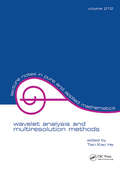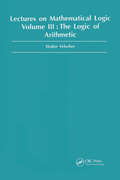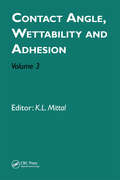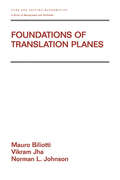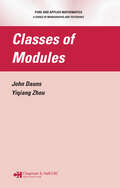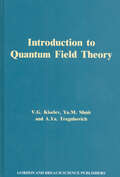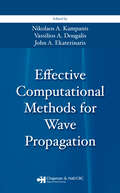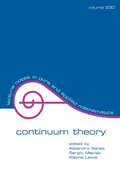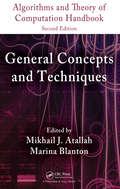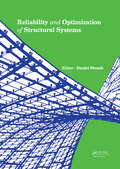- Table View
- List View
Partial Integral Operators and Integro-Differential Equations: Pure and Applied Mathematics (Chapman & Hall/CRC Pure and Applied Mathematics)
by Jürgen M. Appell Anatolij S. Kalitvin Petr P. ZabrejkoA self-contained account of integro-differential equations of the Barbashin type and partial integral operators. It presents the basic theory of Barbashin equations in spaces of continuous or measurable functions, including existence, uniqueness, stability and perturbation results. The theory and applications of partial integral operators and linea
Wavelet Analysis and Multiresolution Methods (Lecture Notes in Pure and Applied Mathematics)
by Tian-Xiao HeThis volume contains papers selected from the Wavelet Analysis and Multiresolution Methods Session of the AMS meeting held at the University of Illinois at Urbana-Champaign. The contributions cover: construction, analysis, computation and application of multiwavelets; scaling vectors; nonhomogenous refinement; mulivariate orthogonal and biorthogona
Surface Modeling: High Accuracy and High Speed Methods (Applied Ecology and Environmental Management)
by Tian-Xiang YueAlthough GIS provides powerful functionality for spatial analysis, data overlay and storage, these spatially oriented systems lack the ability to represent temporal dynamics, which is a major impediment to its use in surface modeling. However, rapid development of computing technology in recent years has made real-time spatial analysis and real-tim
Logic of Arithmetic
by Walter FelscherFor propositional logic it can be decided whether a formula has a deduction from a finite set of other formulas. This volume begins with a method to decide this for the quantified formulas of those fragments of arithmetic which express the properties of order-plus-successor and of order-plus-addition (Pressburger arithmetic). It makes use of an alg
Flat Rolling Fundamentals (Manufacturing Engineering and Materials Processing)
by Vladimir B. Ginzburg Robert BallasThis volume compiles information from physics, metallurgy, and mechanical and electrical engineering to epitomize the fundamental characteristics of flat rolling steel. Flat Rolling Fundamentals is drawn from in-depth analyses of metal properties and behaviors to technologies in application. The book provides a full characterization of steel, including structure, chemical composition, classifications, physical properties, deformation, and plasticity. The authors present different types of rolling mills and the defining physical analytical parameters.They also discuss the effects of hot rolling on steel and the role of lubrication and thermomechanical treatments to minimize these effects. This book presents qualitative and quantitative advances in cost-effective steel production.
Site Assessment and Remediation Handbook
by Martin N. SaraCompletely revised and updated, the Second Edition of Site Assessment and Remediation Handbook provides coverage of new procedures and technologies for an expanded range of site investigations. With over 700 figures, tables, and flow charts, the handbook is a comprehensive resource for engineers, geologists, and hydrologists conducting site investi
Contact Angle, Wettability and Adhesion, Volume 3
by K. L. MittalThis volume chronicles the proceedings of the Third International Symposium on Contact Angle, Wettability and Adhesion held in Providence, Rhode Island, May 20a 23, 2002. This symposium was held to provide a forum to update and consolidate the research activity on this topic. The world of wettability is very wide as it plays an extremely important
Foundations of Translation Planes (Chapman & Hall/CRC Pure and Applied Mathematics)
by Norman Johnson Vikram Jha Mauro BiliottiAn exploration of the construction and analysis of translation planes to spreads, partial spreads, co-ordinate structures, automorphisms, autotopisms, and collineation groups. It emphasizes the manipulation of incidence structures by various co-ordinate systems, including quasisets, spreads and matrix spreadsets. The volume showcases methods of str
Classes of Modules (Chapman & Hall/CRC Pure and Applied Mathematics)
by John Dauns Yiqiang ZhouBecause traditional ring theory places restrictive hypotheses on all submodules of a module, its results apply only to small classes of already well understood examples. Often, modules with infinite Goldie dimension have finite-type dimension, making them amenable to use with type dimension, but not Goldie dimension. By working with natural classes
Introduction to Quantum Field Theory
by V.lG. Kiselev Ya.M. Shnir A.Ya. TregubovichThis text explains the features of quantum and statistical field systems that result from their field-theoretic nature and are common to different physical contexts. It supplies the practical tools for carrying out calculations and discusses the meaning of the results. The central concept is that of effective action (or free energy), and the main t
Effective Computational Methods for Wave Propagation
by Nikolaos A. Kampanis Vassilios A. Dougalis John A. EkaterinarisDue to the increase in computational power and new discoveries in propagation phenomena for linear and nonlinear waves, the area of computational wave propagation has become more significant in recent years. Exploring the latest developments in the field, Effective Computational Methods for Wave Propagation presents several modern, valuable
eWork and eBusiness in Architecture, Engineering and Construction: ECPPM 2012
by Raimar Scherer Gudni GudnasonSince 1994, the European Conferences of Product and Process Modelling (www.ecppm.org) have provided a review of research, development and industrial implementation of product and process model technology in the Architecture, Engineering, Construction and Facilities Management (AEC/FM) industry. Product/Building Information Modelling has matured sig
Continuum Theory
by Sergio Macías Wayne Lewis Alejandro IllanesCelebrating the work of world-renowned mathematician Sam B. Nadler, Jr., this reference examines the most recent advances in the analysis of continua. The book offers articles on the contributions of Professor Nadler, theorems on the structure and uniqueness of hyperspaces, results on the dynamics of solenoids, examples involving inverse limits of
Algorithms and Theory of Computation Handbook, Volume 1: General Concepts and Techniques (Chapman & Hall/CRC Applied Algorithms and Data Structures series)
by Mikhail J. Atallah Marina BlantonAlgorithms and Theory of Computation Handbook, Second Edition: General Concepts and Techniques provides an up-to-date compendium of fundamental computer science topics and techniques. It also illustrates how the topics and techniques come together to deliver efficient solutions to important practical problems. Along with updating and revising many
Introduction to Radiation Acoustics (The Physics and Technology of Particle and Photon Beams)
by Alexander Kalinichenko Valentine T. Lazurik Illya I. ZalyubovskyIn this volume, the author explains a generalized theory of radiation acoustic phenomena. This concise and comprehensive introduction to the field of radiation acoustics considers the nonlinear and non-thermal mechanisms of sound generation as well as the fundamental equations of radiation acoustics. The author also explores topics beyond theory and postulates some applications of radiation acoustic effects. Introduction to Radiation Acoustics is ideal for graduate students and specialists in the fields of accelerator techniques, acoustics, radiotherapeutics, and elementary particle physics.
Control Theory of Partial Differential Equations (Lecture Notes in Pure and Applied Mathematics)
by Oleg Imanuvilov; Guenter Leugering; Roberto Triggiani; Bing-Yu ZhangThe field of control theory in PDEs has broadened considerably as more realistic models have been introduced and investigated. This book presents a broad range of recent developments, new discoveries, and mathematical tools in the field. The authors discuss topics such as elasticity, thermo-elasticity, aero-elasticity, interactions between fluids a
Reliability and Optimization of Structural Systems
by D. StraubThis volume contains 28 papers by renowned international experts on the latest advances in structural reliability methods and applications, engineering risk analysis and decision making, new optimization techniques and various applications in civil engineering. Moreover, several contributions focus on the assessment and optimization of existing str
Capillary Flows with Forming Interfaces
by Yulii D. ShikhmurzaevCapillary Flows with Forming Interfaces explores numerous theoretical problems that arise in the mathematical description of capillary flows. It focuses on developing a unified approach to a variety of seemingly very different capillary flows of practical importance where classical fluid mechanics leads to nonphysical results.The book begin
Life-Cycle of Structures and Infrastructure Systems: PROCEEDINGS OF THE EIGHTH INTERNATIONAL SYMPOSIUM ON LIFE-CYCLE CIVIL ENGINEERING (IALCCE 2023), 2-6 JULY, 2023, POLITECNICO DI MILANO, MILAN, ITALY
by Dan M. Frangopol Fabio BiondiniLife-Cycle of Structures and Infrastructure Systems collects the lectures and papers presented at IALCCE 2023 – The Eighth International Symposium on Life-Cycle Civil Engineering held at Politecnico di Milano, Milan, Italy, 2-6 July, 2023. This Open Access Book contains the full papers of 514 contributions, including the Fazlur R. Khan Plenary Lecture, nine Keynote Lectures, and 504 technical papers from 45 countries.The papers cover recent advances and cutting-edge research in the field of life-cycle civil engineering, including emerging concepts and innovative applications related to life-cycle design, assessment, inspection, monitoring, repair, maintenance, rehabilitation, and management of structures and infrastructure systems under uncertainty. Major topics covered include life-cycle safety, reliability, risk, resilience and sustainability, life-cycle damaging processes, life-cycle design and assessment, life-cycle inspection and monitoring, life-cycle maintenance and management, life-cycle performance of special structures, life-cycle cost of structures and infrastructure systems, and life-cycle-oriented computational tools, among others.This Open Access Book provides an up-to-date overview of the field of life-cycle civil engineering and significant contributions to the process of making more rational decisions to mitigate the life-cycle risk and improve the life-cycle reliability, resilience, and sustainability of structures and infrastructure systems exposed to multiple natural and human-made hazards in a changing climate. It will serve as a valuable reference to all concerned with life-cycle of civil engineering systems, including students, researchers, practicioners, consultants, contractors, decision makers, and representatives of managing bodies and public authorities from all branches of civil engineering.
Essential Physics
by John Matolyak Ajawad HaijaFluency with physics fundamentals and problem-solving has a collateral effect on students by enhancing their analytical reasoning skills. In a sense, physics is to intellectual pursuits what strength training is to sports. Designed for a two-semester algebra-based course, Essential Physics provides a thorough understanding of the fundamentals of ph
Hindi Kumarbharati class 9 - Maharashtra Board: हिंदी कुमारभारती ९वीं कक्षा - महाराष्ट्र बोर्ड
by Maharashtra Rajya Pathyapustak Nirmiti Va Abhysakram Sanshodhan Mandal Puneहिंदी कुमारभारती कक्षा 9 की पाठ्यपुस्तक का उद्देश्य छात्रों को हिंदी भाषा, साहित्य, और सांस्कृतिक मूल्यों से परिचित कराना है। यह पुस्तक विविध साहित्यिक विधाओं जैसे कविता, कहानी, निबंध, पत्र, एकांकी, हास्य-व्यंग्य, और यात्रा-वृत्तांत का समावेश करती है। विद्यार्थियों की रचनात्मकता, भाषा कौशल, और साहित्यिक अभिरुचि को विकसित करने के लिए इसमें शैक्षणिक और रोचक सामग्री प्रदान की गई है। इस पुस्तक में भाषा के व्यावहारिक प्रयोग और साहित्यिक कृतियों के माध्यम से छात्रों को विचारशीलता, संवेदनशीलता, और नैतिकता के गुण विकसित करने का प्रयास किया गया है। साहित्यिक अध्ययन के साथ, यह पुस्तक बच्चों को व्याकरणिक समझ और सामाजिक चेतना को भी गहराई से विकसित करने का मार्गदर्शन देती है।
Hindi Balbharati class 6 - Maharashtra Board: हिंदी बालभारती ६वीं कक्षा - महाराष्ट्र बोर्ड
by Maharashtra Rajya Pathyapustak Nirmiti Va Abhysakram Sanshodhan Mandal Pune"हिंदी बालभारती" (छठी कक्षा) यह पाठ्यपुस्तक विद्यार्थियों के भाषा कौशल के विकास हेतु तैयार की गई है। इसमें कविता, कहानी, निबंध, संवाद और हास्य-व्यंग्य जैसी विविध साहित्यिक विधाओं को शामिल किया गया है। पुस्तक का उद्देश्य विद्यार्थियों को हिंदी भाषा के व्यावहारिक एवं सृजनात्मक प्रयोगों से परिचित कराना है। इसमें नैतिक मूल्यों, पर्यावरण संरक्षण, वैज्ञानिक दृष्टिकोण, सामाजिक समरसता और जीवन कौशल पर विशेष बल दिया गया है। पाठ्यपुस्तक को विद्यार्थियों के अनुभव, आयु और अभिरुचि को ध्यान में रखते हुए रोचक और चित्रमय रूप में प्रस्तुत किया गया है। साथ ही, अभ्यास प्रश्नों, गतिविधियों और परियोजनाओं के माध्यम से आत्मनिर्भरता एवं तार्किक चिंतन को बढ़ावा दिया गया है। यह पुस्तक विद्यार्थियों की कल्पनाशक्ति, विचार शक्ति और भाषा दक्षता को विकसित करने में सहायक सिद्ध होगी।
Parisar Adyayan Bhag-1 class 4 - Maharashtra Board: परिसर अध्ययन भाग-१ ४थीं कक्षा - महाराष्ट्र बोर्ड
by Maharashtra Rajya Pathyapustak Nirmiti Va Abhysakram Sanshodhan Mandal Pune"परिसर अध्ययन (भाग 1)" महाराष्ट्र राज्य पाठ्यपुस्तक मंडल द्वारा प्रकाशित चौथी कक्षा के लिए एक महत्वपूर्ण पाठ्यपुस्तक है। यह पुस्तक विद्यार्थियों को उनके प्राकृतिक, सामाजिक, और सांस्कृतिक परिवेश को समझने में मदद करती है। इसमें प्राणियों, पौधों, जल, हवा, मानचित्र, परिवहन, संचार, प्राकृतिक आपदाएँ और सामूहिक जीवन जैसे विषयों को सरल और रोचक भाषा में प्रस्तुत किया गया है। पुस्तक का उद्देश्य बच्चों में पर्यावरणीय जागरूकता बढ़ाना, सामूहिक उत्तरदायित्व सिखाना और जीवन कौशल विकसित करना है। इसके अध्याय गतिविधियों, स्वाध्याय और रोचक चित्रों से भरे हैं, जो बच्चों की कल्पनाशक्ति और रचनात्मकता को प्रेरित करते हैं। यह पुस्तक बच्चों को पर्यावरण का सम्मान करना, संसाधनों का उपयोग सही तरीके से करना, और वैज्ञानिक दृष्टिकोण अपनाने के लिए प्रेरित करती है। यह बच्चों के व्यवहार, ज्ञान और सोचने की क्षमता को सुधारने में मददगार है।
Khele Karen Sikhen class 3 - Maharashtra Board: खेलें करें सीखें ३रीं कक्षा - महाराष्ट्र बोर्ड
by Maharashtra Rajya Pathyapustak Nirmiti Va Abhysakram Sanshodhan Mandal Pune'खेलें, करें, सीखें' पाठ्यपुस्तक तीसरी कक्षा के विद्यार्थियों के लिए तैयार की गई है, जो स्वास्थ्य, शारीरिक शिक्षा, कला और कार्यानुभव जैसे विषयों को समग्र रूप से समेटती है। इसमें बच्चों को शारीरिक गतिविधियाँ, खेल, कला-कौशल, और प्राकृतिक पर्यावरण की जानकारी देकर जीवन कौशल सिखाने पर जोर दिया गया है। यह पुस्तक विभिन्न शैक्षणिक अनुभवों, रंगीन चित्रों, वर्कशीट्स और रचनात्मक उपक्रमों के माध्यम से बच्चों को पढ़ाई में रुचि दिलाती है। कक्षा की सजावट, जल साक्षरता, व्यायाम, योग, और आपदा प्रबंधन जैसे विषय सरल गतिविधियों के जरिए बच्चों तक पहुँचाए जाते हैं। साथ ही, छात्रों को व्यावसायिक ज्ञान, तकनीकी कौशल, और सांस्कृतिक गतिविधियों के प्रति प्रोत्साहित किया गया है। यह पाठ्यक्रम छात्रों में रचनात्मकता, टीमवर्क और आत्मविश्वास बढ़ाने में सहायक है।
Swavikas Aur Kalarsaswad class 10 - Maharashtra Board: स्व-विकास और कलारसास्वाद विज्ञान १०वीं कक्षा - महाराष्ट्र बोर्ड
by Maharashtra Rajya Pathyapustak Nirmiti Va Abhysakram Sanshodhan Mandal Pune"स्व-विकास और कलारसास्वाद" इस पुस्तक का मुख्य उद्देश्य विद्यार्थियों के समग्र विकास के लिए आवश्यक जीवन कौशल और कला के प्रति सराहना विकसित करना है। "स्व-विकास और कला रसास्वाद" पाठ्यपुस्तक विद्यार्थियों को आत्मनिरीक्षण, स्व-प्रबंधन, और विभिन्न जीवन परिस्थितियों का विश्लेषण करने की क्षमता प्रदान करती है। इसमें नागरिकता, लोकतंत्र, और सांस्कृतिक विविधता को समझने पर विशेष जोर दिया गया है। इसके अतिरिक्त, यह पुस्तक कला के विभिन्न रूपों, जैसे दृश्य और प्रदर्शन कलाओं के माध्यम से सृजनशीलता और अभिव्यक्ति के महत्व को रेखांकित करती है। पाठ्यक्रम में जीवन के हर क्षेत्र में जिम्मेदारी, संवेदनशीलता और सहयोग के मूल्यों को आत्मसात करने के लिए अनेक गतिविधियाँ और अभ्यास दिए गए हैं। छात्रों को आत्मनिर्भर और जिम्मेदार नागरिक बनने के लिए प्रेरित करते हुए यह पुस्तक उन्हें जीवन और कला के प्रति सकारात्मक दृष्टिकोण अपनाने का संदेश देती है।

